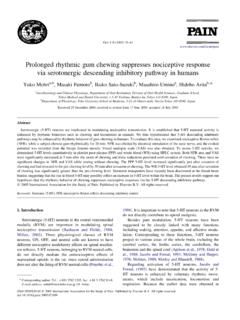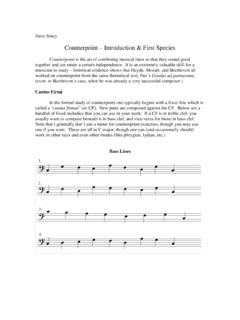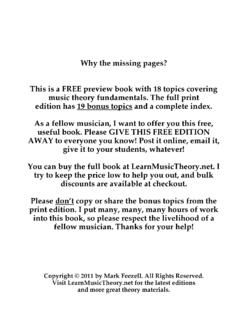Transcription of How to Practice Scales - Creative Guitar Studio
1 How to Practice ScalesBy Andrew WassonStep #1). Make a 5-Day Practice Plan In order to cycle through as many areas of scale Practice as possible (and not get bored) it is important to have a plan. Your plan should cover several days and allow for varied work on each day. Let s look at a typical 5-Day Practice Routine. | Day 1 | Day 2 | Day 3 | Day 4 | Day 5 | Keys: C F A Ab ? G Bb E Db ? D Eb B Gb ?
2 Use days one through four (doing your best) to cover all of the musical keys. On day five - keep it open to work on keys that perhaps never got the attention they deserved. KEEP IN can be interrupted or even sometimes, (due to personal schedules), Practice time can become diminished day to day if you re having a bad week. If you had a fantastic Practice week, use Day 5 to simply review. Or, use it to spend time on an area you find especially fun, (perhapsimprovising or composing a jam track).Step #2). Commit the Geometry of Each Shape to MemoryMake a study of the shape below. Memorize it so you do not need to look at the page whileperforming the scale .
3 Always begin and end the scale on the lowest pitch circled dot. MAJOR scale PATTERN 4: Note: The circled dots are the Scales keynotes or Tonic Notes. If you want a, G Major, scale , then the circled dots need to be located upon, G, notes. Creative Guitar Studio 2009 How to Practice Scales - Page 2By Andrew Wasson Make a study of the shapes below. Memorize them so you do not need to look at the page whileperforming the scale . Always begin and end the scale on the lowest pitch circled dot, (Tonic). MAJOR scale PATTERN 5: MAJOR scale PATTERN 1: MAJOR scale PATTERN 2: MAJOR scale PATTERN 3: Creative Guitar Studio 2009 How to Practice Scales - Page 3By Andrew WassonStep #3).
4 Begin Practice with a MetronomeStart off at a slower pace (between mid 60 s to mid 70 s ). Work through all of the rhythmic durations building metronome speed:- Eighth-Notes, Eighth-Note Triplets, an initial goal of reaching Sixteenth-Notes at a speed of between 92 - 100 that goal has been reached, further develop the Scales with work on Sixteenth-Note tripletsand Thirthy-Second Notes. The metronome speed will likely need to be lowered to a slower(approx. 60 metronome rate) to achieve this level of #4). Practice moving between scale the Scales overlapp, it doesn t take much effort to move between two adjacent scale patterns.
5 An excellent process to begin with is to ascend up one shape and descenddown an adjacent to use a metronome and begin (and end) on the tonal center note. In other words, if youare practicing G Major scale , be sure to begin and end on the G. Step #5). Apply scale Sequencing Patterns to the sequencing is slightly time consuming the very first times one practices it. However,the good news is once they are learned, the sequence is able to be transferred quite rapidly toanother : Be careful not to overdo The sequences can be quite demanding on the sequnces include: (a). Diatonic 3rd s: 1 - 3, 2 - 4, 3 - 5, 4 - 6, etc.
6 (b). Ascending 4th s: 1 - 2 - 3 - 4, 2 - 3 - 4 - 5, 3 - 4 - 5 - 6, etc. (c). Acsending 3rd s & Back: 1 - 2 - 3 - 1, 2 - 3 - 4 - 2, 3 - 4 - 5 - 3, etc. Creative Guitar Studio 2009 How to Practice Scales - Page 4By Andrew WassonStep #6). Study the use of each scale over jam track often students begin practicing Scales , but then stop because they cannot understand howthe Scales are properly used to create music. It is vital that students Practice using the scalesover jam track progressions. Only through this type of Practice can one truly understand the applieduse of Scales in context. And, of course, get very good at using cross over study of rhythm Guitar occurs when students write progressions inkey and record the progressions for later use as jams.
7 This method also helps build betterknowledge of the use of harmony and theory through applied the progression below. It is written in the key of G Major. Play the chord changesalong with the Jam Track provided free for download on our website. When you feel good aboutthe chords, the sound of the changes and the groove begin practicing improv. over the progressionusing the G Major scale , #7). Also work on the Pentatonic Scales & Arpeggios It can be far too easy to limit ones work to only scale Practice . However, by applying equal time(as you work on the Scales ) to the study of Pentatonics and arpeggios, you will noticemassive benefits when practicing for all other the Scales , (as well as arpeggio s), are given on the pages that follow.
8 Creative Guitar Studio 2009 How to Practice Scales - Page 5By Andrew Wasson Creative Guitar Studio 2009 How to Practice Scales - Page 6By Andrew Wasson Creative Guitar Studio 2009





